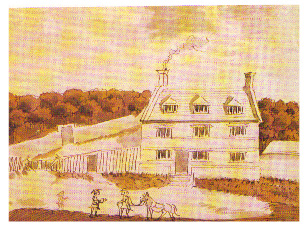
Woolsthorpe Manor. An early 18th century sketch by William Stukely.
|
|
|
|
|
|
|
|
|
|
|
|
|
|
|
|
|
|
What did Isaac do now?
In 1665 and 1666, the Plague affected England. Students at Cambridge were sent home as the University closed. Isaac went to stay with his mother in Woolsthorpe. These next two years were to prove valuable to science, as he spent the time working on his ideas.
 |
Woolsthorpe Manor. An early 18th century sketch by William Stukely. |
| Illustration in The Ascent of Man by J. Bronowski (1973) |
One story, which is probably untrue, is that Newton was pointed towards his theory of gravity whilst sitting under an apple tree in the orchard. When an apple landed on his head he saw its fall as being like the fall of the moon through the sky. This led him to develop his theory of the pull of the Earth, the Sun and the planets on each other: his idea of universal gravitation. He was able to prove his theory using a type of mathematics he invented called 'fluxions', which is now called calculus. Worried that someone would steal his ideas, Newton kept this secret for almost twenty years.
Back at Cambridge in 1667, Newton was made a Fellow of Trinity College and in 1669, he replaced his former teacher, Isaac Barrow as Lucasian Professor of Mathematics. In this position he had to teach other people and so had to talk and write about his work.